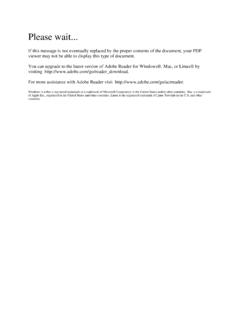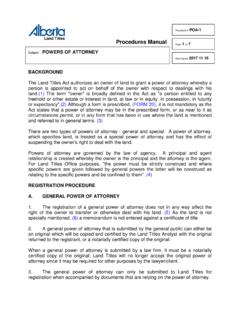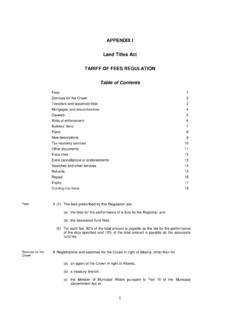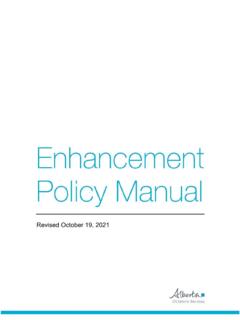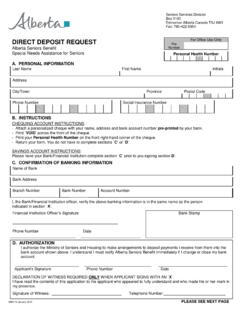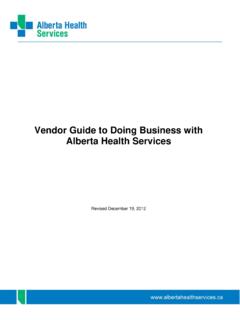Transcription of Guide to Using Surveillance Cameras in Public Areas
1 Guide to Using Surveillance Cameras In Public Areas Revised June 2004 ISBN 0-7785-3125-2 Produced by: Access and Privacy Service Alberta 3rd Floor, 10155 102 Street Edmonton, Alberta, Canada T5J 4L4 Office Phone: 780-422-2657 Fax: 780-427-1120 foip Help Desk: 780-427-5848 Toll free dial 310-0000 first E-mail: Websites: Freedom of Information and Protection of Privacy Guide to Using Surveillance Cameras in Public Areas Table of Contents Chapter 1 1 Chapter 2 1 Chapter 3 Collecting Personal Information Using Surveillance 2 Chapter 4 Considerations Prior to Using Surveillance Cameras .. 2 Chapter 5 Developing a Surveillance System 3 Chapter 6 Designing and Installing Surveillance Equipment.
2 4 Chapter 7 Access, Use, Disclosure, Retention and Destruction of Surveillance 5 Chapter 8 Auditing the Use of Surveillance Chapter 9 Role of the Information and Privacy 6 Bibliography .. 8 ACKNOWLEDGMENTS This Guide is based upon and imports many of the policies and guidelines outlined in the British Columbia Office of the Information and Privacy Commissioner s Public Surveillance System Privacy Guidelines, OIPC Policy 00-01, June 21, 2000. That contribution is gratefully acknowledged. Input and advice on the content of the Guide was also received from the Office of the Information and Privacy Commissioner of Alberta. The contribution of that Office is also gratefully acknowledged.
3 Guide to Using Surveillance Cameras in Public Areas Revised June 2004 Page 1 1. INTRODUCTION Surveillance Cameras can be an effective technique to protect Public safety and detect or deter criminal activity. Surveillance Cameras are increasingly being installed inside and outside of Public buildings (in elevators, hallways, entrances, etc.), on streets, highways, in parks and Public transportation vehicles. Public bodies subject to the Freedom of Information and Protection of Privacy Act (the foip Act) must balance the benefits to the Public against the rights of individuals to be left alone. A key issue in privacy protection is the regulation of the collection of personal information, thereby preventing unnecessary Surveillance of individuals.
4 This Guide is intended to assist Public bodies in deciding whether collection of personal information by means of a Surveillance camera is both lawful and justifiable and, if so, in understanding how privacy protection measures can be built into the use of a Surveillance system. The guidelines do not apply to covert or overt Surveillance Cameras being used by a Public body as a case-specific investigation tool for law enforcement purposes, where there is statutory authority and/or the authority of a search warrant to conduct the Surveillance . They are also not intended to apply to workplace Surveillance systems installed by a Public body employer to conduct Surveillance of employees. Other considerations may apply to this type of Surveillance and will not be covered in this Guide .
5 2. DEFINITIONS In this Guide : Covert Surveillance refers to the secretive continuous or periodic observation of persons, vehicles, places or objects to obtain information concerning the activities of individuals, which is then recorded in material form, including notes and photographs . 1 Personal Information is defined in section 1(n) of the foip Act as recorded information about an identifiable individual, including: the individual s race, colour, national or ethnic origin; the individual s age or sex; the individual s inheritable characteristics; information about an individual s physical or mental disability; and any other identifiable characteristics listed in that section. Surveillance System refers to a mechanical or electronic system or device that enables continuous or periodic video recording, observing or monitoring of personal information about individuals in open, Public spaces (including streets, highways, parks), Public buildings (including provincial and local government buildings, libraries, health care facilities, Public housing and educational institutions) or Public transportation, including school 1 Covert Surveillance in Commonwealth Administration.
6 Guidelines, Human Rights and Equal Opportunity Commission, February, 1992 Guide to Using Surveillance Cameras in Public Areas Page 2 Revised June 2004 and municipal transit buses or other similar vehicles. Reception Equipment refers to the equipment or device used to receive or record the personal information collected through a Public Surveillance system, including a camera or video monitor. Record is defined in section 1(q) of the foip Act as a record of information in any form and includes notes, images, audio-visual recordings, x-rays, books, documents, maps, drawings, photographs, letters, vouchers and papers and any other information that is written, photographed, recorded or stored in any manner, but does not include software or any mechanism that produces records.
7 In the context of this Guide , record includes digitally recorded or stored media such as images on videotape. Storage Device refers to a videotape, computer disk or drive, CD ROM or computer chip used to store the recorded visual images captured by a Surveillance system. 3. COLLECTING PERSONAL INFORMATION Using Surveillance Cameras Any record of the image of an identifiable individual is a record of personal information. Since Surveillance systems collect personal information about identifiable individuals, Public bodies must determine if they have the authority to collect personal information under section 33 of the foip Act. Under that section, no personal information may be collected by or for a Public body unless the collection is expressly authorized by an enactment of Alberta or Canada (section 33(a)); the information is collected for the purposes of law enforcement (section 33(b)); or the information relates directly to and is necessary for an operating program or activity of the Public body (section 33(c)).
8 Public bodies must be able to demonstrate to the Information and Privacy Commissioner that any proposed or existing collection of personal information by Surveillance Cameras is authorized under one of the above sections of the Act. 4. CONSIDERATIONS PRIOR TO Using Surveillance Cameras In order to comply with Part 2 of the foip Act, the foip Guidelines and Practices publication recommends that Public bodies consider the following before deciding to use Surveillance : Surveillance Cameras should be used only where conventional means for achieving the same objectives are substantially less effective than Surveillance and the benefits of Surveillance substantially outweigh any reduction of privacy in the existence and use of the system.
9 Guide to Using Surveillance Cameras in Public Areas Revised June 2004 Page 3 The use of a Surveillance camera should be able to be justified on the basis of verifiable, specific reports of incidents of crime ( vandalism, theft), safety concerns or other compelling circumstances. A Privacy Impact Assessment (PIA) should be completed to assess the effects that the proposed Surveillance system may have on privacy and the ways in which any adverse effects can be mitigated (see Chapter 9). In Investigation Report F2003-IR-005, the Commissioner referred to the PIA previously submitted by the local Public body as a basis for his findings. Consultations may be conducted with relevant stakeholders as to the necessity, and acceptability to the Public , of the proposed Surveillance .
10 Ensure that the proposed design and operation of the system creates no greater privacy intrusion than is absolutely necessary to achieve its goals. Prior to deciding to use covert Surveillance for a purpose other than a case-specific law enforcement activity, Public bodies should conduct a comprehensive PIA and provide it, together with the case for implementing covert Surveillance to the Office of the Information and Privacy Commissioner. The purpose of the PIA is to ensure that covert Surveillance is the only available option and that the benefits derived from the personal information obtained would far outweigh the violation of privacy of the individuals observed. A Public body that regularly uses covert Surveillance as a case-specific investigation tool for law enforcement purposes may, as part of sound privacy protection practices, consider developing a protocol that establishes how the decision is made to use covert Surveillance in a given case.


